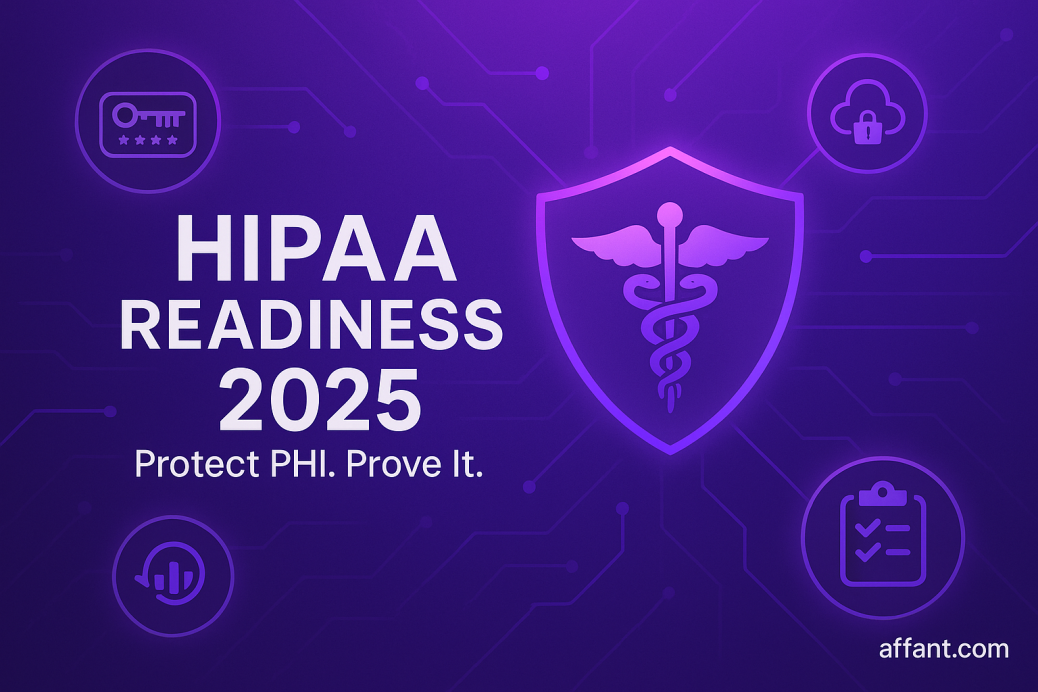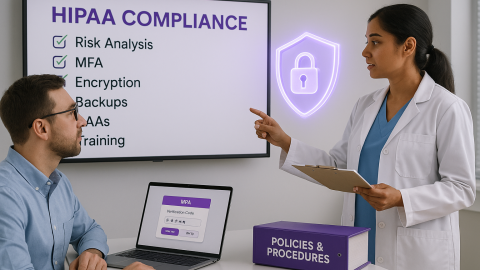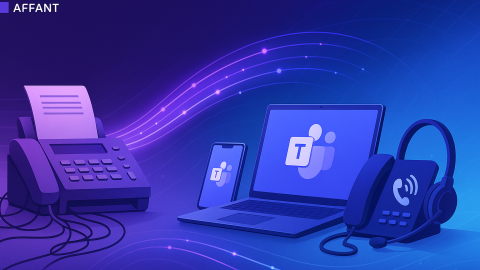If HIPAA is the rulebook for protecting patient data, 2024–2025 has been a year of rule updates and playbook add-ons. Below, we translate the latest shifts into clear terms and outline a practical path forward—plus how Affant can support the journey without drowning you in buzzwords or busywork.
Quick refresher
HIPAA sets the baseline for safeguarding electronic protected health information (ePHI). Around it, several changes have raised expectations: tighter privacy protections for sensitive care, updates on how tracking tools should (or should not) be used on health sites and apps, proposed upgrades to the Security Rule, closer alignment for substance-use disorder records, sector cybersecurity goals, and stronger expectations for appropriate information sharing. Together, these changes nudge organizations toward verifiable, modern security.
What’s new (in simple terms)
1) Stronger privacy expectations
Some disclosures—especially around sensitive care—now require more restraint and clearer documentation. Notices and workflows should reflect what actually happens in your systems.
2) Security Rule upgrades are on the horizon
Think of multifactor authentication (MFA), encryption in transit and at rest, vendor oversight, and formal incident response and recovery as the expected baseline rather than “nice to have.”
3) Tracking tech can create hidden risk
Analytics pixels, session replay, and ad tools on health-related pages can turn routine browsing into regulated data. Either control these tools with appropriate safeguards or remove them.
4) Harmonizing special records
Rules for substance-use disorder records now align more closely with HIPAA, so consent, disclosures, and breach response should follow one coherent playbook.
5) Sector cybersecurity goals = a sensible to-do list
Prioritize MFA, asset inventory, tested backup/restore, and enough visibility (logs/alerts) to make failures obvious and fast to contain.
6) Share when you should, protect what you must
Technology should enable appropriate information sharing while enforcing minimum-necessary access, role-based controls, and reliable audit trails.
What this means for your IT team
- Accounts & access: Enforce MFA for admins and remote access. Use encryption widely. Retire legacy protocols that bypass modern controls.
- Web & mobile front doors: Treat pixels and SDKs like any other data collector. If they can see PHI, they need guardrails—or they need to go.
- Backup & recovery: Be able to restore quickly from clean, immutable backups. Test it, document it, fix what breaks.
- Vendors & agreements: If a partner touches ePHI, ensure contracts and monitoring reflect that reality.
- Paperwork that matches reality: Policies, privacy notices, consent language, and patient-facing disclosures should describe what your systems actually do.
- Recognized practices help: Map your controls to recognized frameworks; keep artifacts that demonstrate due diligence.
How Affant can help (without boiling the ocean)
Affant partners with healthcare organizations to turn these expectations into concrete steps. That usually includes:
- Assessment & prioritization: A clear view of where you stand and what to fix first, sized to your environment.
- Implementation support: Help rolling out MFA, tightening configurations, taming tracking tech, improving backups, and tuning vendor oversight.
- Operational alignment: Streamlined processes so front office, HIM, security, and IT follow the same rules with fewer hand-offs and surprises.
- Evidence you can keep: Practical documentation—config exports, test results, and concise summaries—so leadership, payers, and auditors understand what’s in place.
No one-size-fits-all blueprint; we tailor the depth and pace to your team and technology stack.
90-day action checklist
- Lock down identities
Enforce MFA for admins and remote access; review break-glass accounts; trim unused legacy auth. - Harden the public edge
Inventory trackers on sites/apps; remove or reconfigure anything that might capture PHI; update consent language where needed. - Prove recovery
Perform at least one tabletop and one live restore for a critical system; document results and close gaps. - Fix the paperwork gap
Align Notices, consent, and disclosures with your real data flows; retrain staff on the updated steps. - Right-size vendor oversight
Classify vendors by PHI exposure; tighten agreements and monitoring where risk is highest. - Show recognized practices
Map controls to a recognized framework; keep a one-page scorecard with owners and target dates.
Bottom line
HIPAA in 2025 is about provable security: MFA on the doors, encryption on the data, recovery you’ve tested, tracking tech that’s tamed, vendors under control, and documents that reflect reality. Affant helps you translate that into a practical plan, make the highest-value changes first, and retain clear evidence of progress—so you’re safer from both attackers and audits.
Want a quick conversation to gauge scope and timelines? Share your approximate user count and core systems (EHR, email, file services), and we’ll outline a sensible starting plan.











